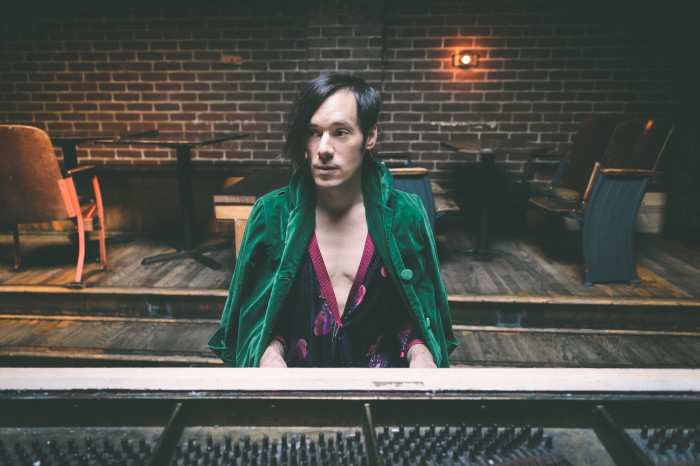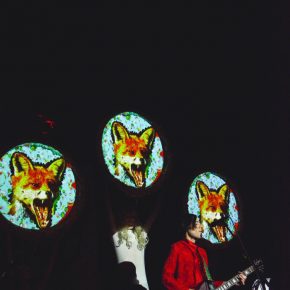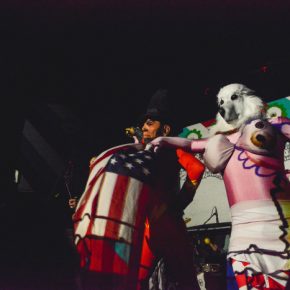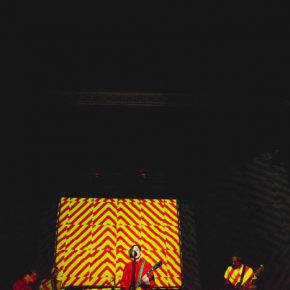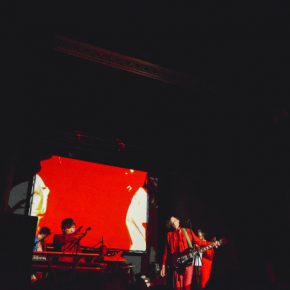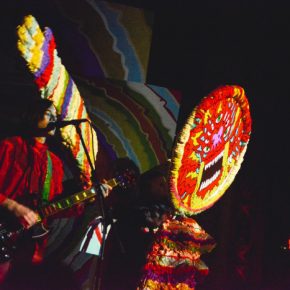Indie-rock group, of Montreal, recently stopped to perform at Tricky Falls in support of their recent album, Aureate Gloom, which was recorded at Sonic Ranch Studios not too far from El Paso, TX. We had a chance to speak with the dynamic multi-instrumentalist and leader of the band, Kevin Barnes, about the creation of his new album, their elaborate stage show and North American tour.
You’re on tour in support your most recent album, Aureate Gloom, which was released earlier this year. What inspired you to create this album?
For the most part, the songs are based on my personal life. At the time I was going through a very heavy transitional period, so I was writing about that. Basically, it’s like an open journal, and I wanted to work quickly and get everything down really fast, so I didn’t have time to second guess anything, or feel self conscious about anything. I wrote it in a short period of time, and we recorded it just outside of El Paso at a studio called Sonic Ranch. We were out there for 3 weeks and we recorded it and mixed it during that time.
You stated the album is based on personal experiences. Did the transition in your life, in regards to your wife and marriage, inspire a lot of that music?
I don’t want to get too deep into the details of my personal life; I’m not necessarily comfortable with that. But needless to say, she is somebody in my life, so some of the songs were inspired by her.
Was the creation of this album therapeutic?
Oh yeah, definitely. I think a lot of times I need to write about things to help me move beyond them. If there’s something I’m struggling with in my life, or some person I’m struggling with, then if I write a song about them or that experience. Often it helps me have a broader perspective about things and be less critical of that person. I’ve written a lot of mean-spirited songs about people, which now I regret, because now I can see their side of it more clearly and I can see I was being cruel. But I kind of needed to write the song because I was so upset, and it helped become cool again.
I’ve read a few articles about your band and in one of the articles you described the album as “all over the place musically.” What did you mean by that?
It just pulls from a wide variety of influences. I was listening to a lot of 70s punk music, the early punk stuff—New York punk especially. Stuff like Television, the Voidoids, the Talking Heads, Johnny Thunders, New York Dolls, Iggy Pop and sort of that influence. Also there was a prog-rock influence with bands like Black Sabbath and King Crimson. So there’s some heavier moments on that record. I wasn’t going for anything contemporary. I was going for an album that could have been made in the 70s.
You have an extensive repertoire of albums, EP’s, and LP’s. Are you always writing, composing and recording music?
For the most part. We’re pretty much done with the new record now, so we’re just always working. It’s great because I have a home studio, so I can pretty much, just when I have any free moment, off tour or whatever, be in my studio working.
Going back to the album, you said there’s a prog-rock influence. Can you elaborate on that?
I’d say probably songs like “Like Ashoka’s Inferno of Memory” and “Monolithic Egress” are probably the most prog-gy—just because there like a bunch of suites and sort of sung together; just kind of more collage-y. I guess most of the record’s pretty collage-y. I think also because they have riffs, guitar riffs, that seem like an important element in prog-rock. It’s kind of fun to make heavier riffs like that.
The artwork for this album blows my mind. I love it. Did David Barnes create the artwork?
He did, yeah.
Did you contribute any ideas to the artwork he created? Or did he listen to the album and then create the artwork?
Normally how it works is…so David can do the art, I start sending him demos really early on so he’s very familiar with the songs as they’re progressing and evolving. Once the record’s done, or before we send it off to get mixed or whatever, he usually spends a really concentrated period of time, like a week, listening to the record on repeat, non stop, just really getting deep into the spirit of the record. We start bouncing ideas off each other of just how I want the visual aspect of it to be, and how he wants the visual aspect of it to be. So then we compromise somewhere in the middle. This one was especially stressful for him because he had a really crazy deadline. The whole thing happened so quickly and he had this really crazy deadline that he had to meet, so he was actually making it while we were on tour. On the tour bus he was actually in the back room all day and night trying to finish it in time. It was kind of hectic for him but I think it turned out really good.
When I think of your band, Of Montreal, I don’t just think of a band—I see it as an entire stage show. Can tell me a little bit about the live show you’re taking on tour?
It’s very visual and psychedelic, and transportive. We have these really vivid, complex, interesting images we project—animations and images we project on stage. We have these performance artists who come out and interact with the visual projections…and then we have lots of costume changes, and some skits and things like that. It’s very theatrical, playful, dynamic production.
What inspires the production, the wardrobe, everything that goes into this live performance?
I think that’s just where our heads are at. We just like that sort of thing and it keeps it interesting for us—to have a lot of movement on stage, and a lot of variety, and it never really becomes like a static image. It’s more fun that way. It’s kind of like a Fellini circus and you have these people who you’re on tour with, traveling with, and everybody is really kind hearted and intelligent, so it’s really just a good group of people.
Listen to “Bassem Sabry“:
Text: Alex Duran
Photo: Saul Torres | Chad Kamenshine

